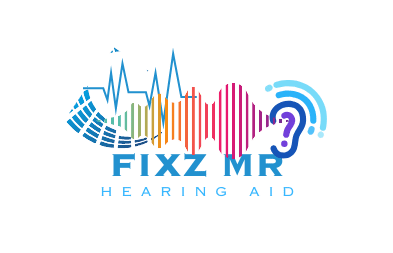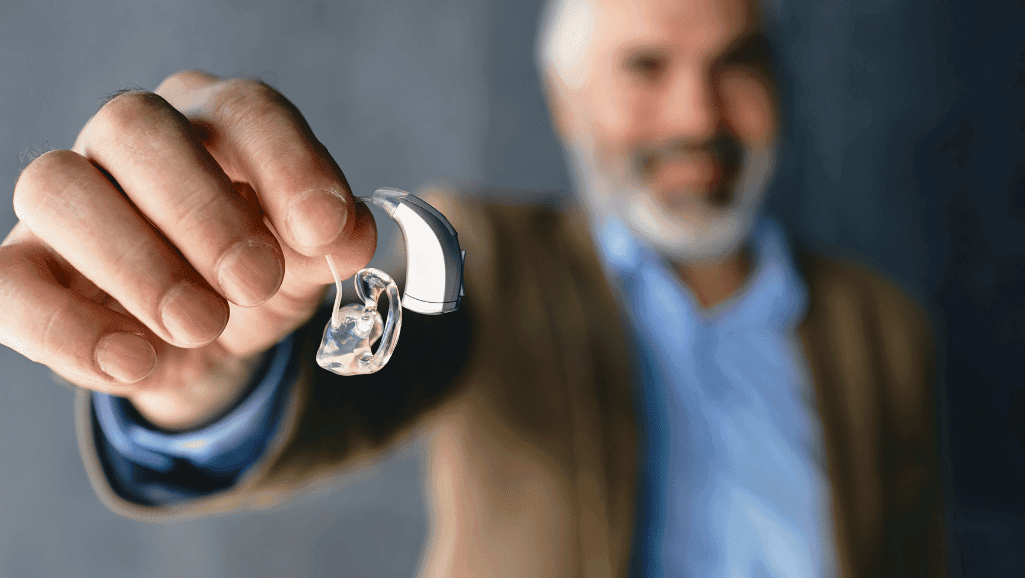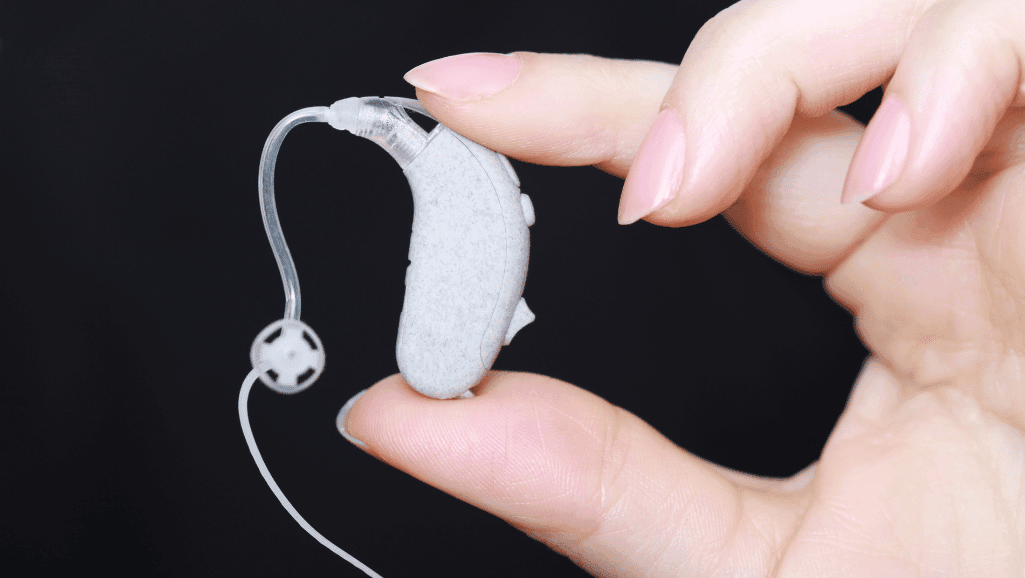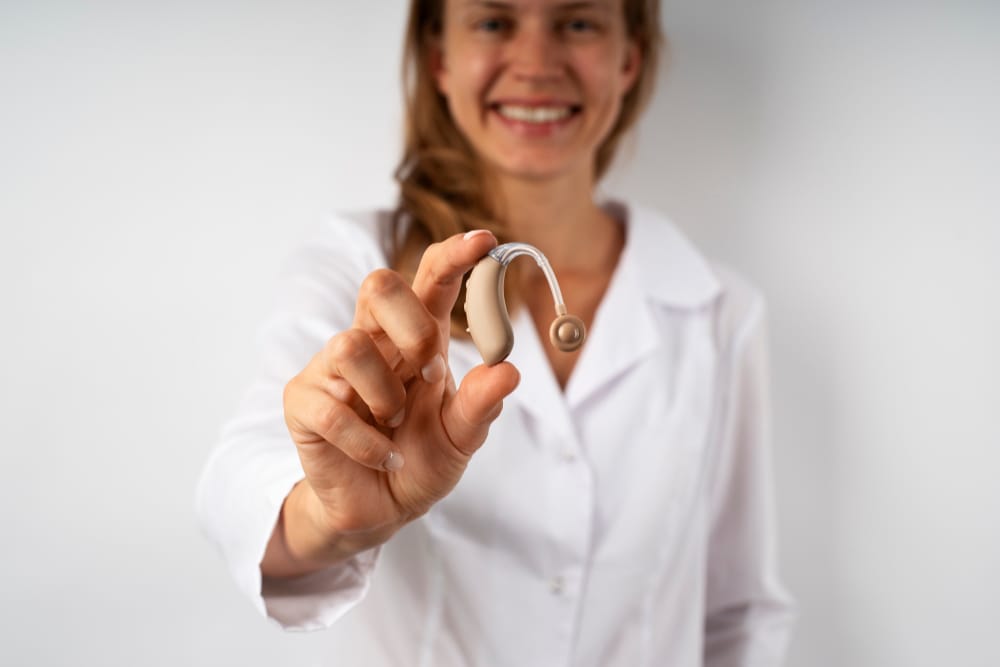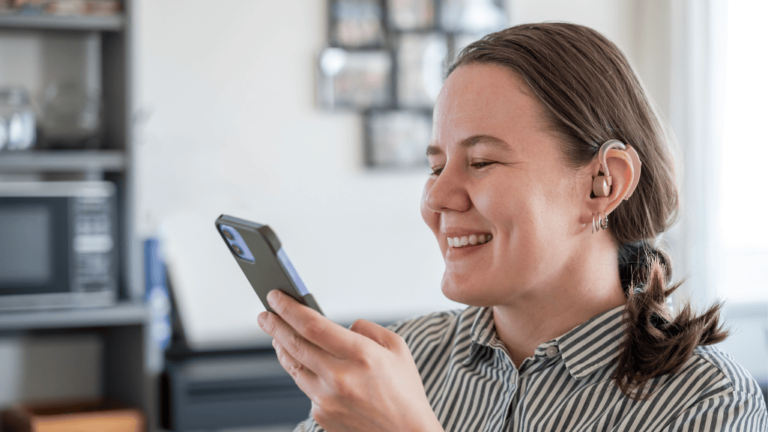Our detailed study included advice from audiologists and thousands of customer opinions. We found the best rechargeable hearing aids offer amazing sound, are easy to use, and save money. Prices for these top-notch devices range from $99 to $7,000 a pair. They also have cool features like digital noise reduction.
These hearing aids are great because you don’t need to change tiny batteries often. This is especially good for seniors or people who have trouble with small tasks. The batteries last 15 to 30 hours per charge, so you can hear clearly all day.
Companies like Jabra Enhance, Audien, and Eargo lead the market with their cutting-edge products. While these rechargeable hearing aids might cost more at first, they offer savings and convenience in the long run.
Key Takeaways
- Rechargeable hearing aids range from $99 to $7,000 per pair.
- Battery life typically lasts 15 to 30 hours between charges.
- Digital noise reduction technology enhances sound clarity.
- Convenient for seniors and those with dexterity challenges.
- Long-term savings from not using disposable batteries.
Introduction to Rechargeable Hearing Aids
The hearing aids market is growing fast because of technology. It is expected to go from $6.67 billion in 2021 to $11.02 billion in 2028. This growth is partly because rechargeable hearing aids are becoming more popular. They offer ease of use, are better for the environment, and help save money.
Why Choose Rechargeable Hearing Aids?
Rechargeable hearing aids are becoming more common. They don’t need battery changes often, which saves time and money. Also, they produce less waste, helping the planet. Experts at the Centre for Hearing rate Phonak and Signia highly for their innovative and effective products.
How Do Rechargeable Hearing Aids Work?
It’s important to know how these hearing aids work. They use batteries like lithium-ion or silver-zinc, which store a lot of energy. Some, like the Phonak’s Generation 3, last up to 30 hours per charge. And, they can make sounds clearer, even in noisy places.
Models like Phonak’s Audéo B-R use Li-ion batteries. Signia, Widex, and ReSound also offer easy charging. Charging them overnight means they’re ready to go in the morning.
As these hearing aids get better, more people want them. They are a reliable choice for those looking for smart, green ways to improve hearing.
Top Rechargeable Hearing Aid Brands
More people are choosing rechargeable hearing aids for convenience and savings. Many brands lead the market, meeting various needs and preferences.
Jabra Enhance: Best for Seniors
Jabra Enhance hearing aids focus on the elderly. They are easy to use and have clear sound. They make a great choice for seniors.
Audien: Most Affordable
Audien hearing devices stand out for being budget-friendly. They offer essential features at a low cost, ideal for those saving money.
Eargo: Best Invisible OTC Hearing Aid
Eargo invisible aid is nearly unseen when worn. It’s the top pick for those who want privacy and quality in their hearing aid.
Lexie B2 Powered by Bose: Most User-Friendly
The Lexie B2 Bose technology is easy to use. It combines modern tech with a simple design, suitable for those wanting easy-to-operate aids.
ReSound Omnia: Most Advanced
ReSound Omnia advanced aids boast the latest technology. They offer superb sound and customization, great for those seeking the best in hearing tech.
Sony CRE-E10: Best Earbud Style
The Sony CRE-E10 earbuds mix style with function. They look good and sound great, perfect for stylish users valuing audio quality.
Go Hearing Go Prime: Most Features for the Money
The Go Hearing Go Prime features offer great value. They come packed with functions that improve listening at an affordable price.
Benefits of Rechargeable Hearing Aids
Rechargeable hearing aids come with many advantages. They are convenient, save money over time, and are better for the planet. These benefits make them a top pick for users.
Convenience and Ease of Use
Rechargeable hearing aid advantages start with how easy they are to use. You won’t have to stop and change batteries often. This means you get clear sound all day. Most can work up to 14-18 hours after charging just once. This makes them ideal for wearing every day, from morning till night.
Cost-Efficiency Over Time
Rechargeable hearing aids also save a lot of money in the long run. Compared to traditional hearing aids, they need far fewer batteries over three years. You could spend $225-400 on 300 disposable batteries. But rechargeable ones might only need six batteries, costing $75-150. This big difference means more money in your pocket.
Environmental Benefits
These aids are eco-friendly hearing aids too. Every year, people throw away over three billion button cell batteries. Choosing rechargeable aids helps cut down this waste. By using fewer disposable batteries, these aids are gentle on the environment. They help make the future a bit greener.
Practical and Advanced Features
Today’s rechargeable hearing aids aren’t just about basic functions. They come with cool tech like Bluetooth and remote adjustments. These options make listening better and adjusting settings a breeze. To keep these aids working well, charge them fully, keep them dry, and handle them with care. This will help them last longer and stay reliable.
| Key Benefits | Details |
|---|---|
| Convenience | No frequent battery changes, all-day use on a single charge |
| Cost-Efficiency | Reduction in battery purchase cost (6 vs. 300 batteries over three years) |
| Environmental Impact | Reduces waste from disposable batteries |
| Advanced Features | Bluetooth connectivity, remote fine-tuning, and other modern functionalities |
| Proper Maintenance | Full charging, keeping dry, careful handling extends lifespan |
The mix of convenience, savings, and care for the planet makes rechargeable hearing aids a great choice. People looking for smart and sustainable hearing solutions are choosing them more and more.
Battery Life and Performance
Understanding hearing aid battery life and performance is key. Users want to get the most from their devices. Rechargeable batteries are now more common in hearing aids. They are easier to use and last longer, making them a top choice.
Charging Time
Fast charging hearing aids get fully charged in three to six hours. This feature makes life easier for users. With a quick charge, you can use them for up to 30 hours. Models like Phonak’s Audéo B-R and Audéo Lumity show this with their great charging and long battery life.
Battery Duration and Longevity
Rechargeable batteries for hearing aids can be charged 500 times. They usually last about five years. This is much better than disposable batteries, which only last up to two weeks. Lithium-ion batteries are used because they are safe and keep their charge well over time.
Factors Affecting Battery Life
Many things can change how long hearing aid batteries last. Using Bluetooth, telecoil features, and tinnitus masking can make batteries run out faster. Weather and high places can also affect them. But high-quality hearing aids are built to work well, no matter the conditions.
Statistics show that 52% of hearing aid users have rechargeable ones. And 89% prefer them over disposables.
These facts make it clear. Rechargeable hearing aids are efficient, eco-friendly, and cost-effective. Many users think they are the better choice.
| Battery Type | Average Lifan | Recharge Cycles |
|---|---|---|
| Disposable | 3-14 days | N/A |
| Rechargeable (Lithium-ion) | 5 years | 500 cycles |
Types of Batteries in Rechargeable Hearing Aids
Rechargeable hearing aids use two main battery types: lithium-ion and silver-zinc. Each kind has special features that meet various needs. Knowing the differences can help you choose wisely.
Lithium-Ion Batteries
Lithium-ion batteries are popular in hearing aids for many reasons. They last longer and charge faster. You can recharge them up to 500 times, which is way more than disposables.
These batteries are sealed in the device, which means they’re easy to take care of. They stay safe from moisture and dirt. Plus, they’re eco-friendly since they don’t have mercury or cadmium. Even though they’re pricier at first, they save you money over time because they last so long.
Silver-Zinc Batteries
Silver-zinc batteries are also used in rechargeable hearing aids, but less so than lithium-ion. They’re great because you can replace them yourself. This could be good if you like to maintain your devices personally. Like their lithium-ion cousins, they’re good for the environment. Yet, they don’t last as long and take more time to charge.
Still, silver-zinc batteries pack a lot of energy, making them reliable. They might not charge as quickly, but they’re an eco-friendly choice. It’s worth thinking about them.
| Feature | Lithium-Ion Batteries | Silver-Zinc Batteries |
|---|---|---|
| Charging Cycles | Up to 500 times | Hundreds of times |
| Charging Speed | Faster | Slower |
| Maintenance | Sealed, maintenance-free | User-replaceable |
| Safety | Does not contain mercury or cadmium | Does not contain harmful substances |
| Environmental Impact | Eco-friendly, recyclable | Eco-friendly, high energy density |
| Cost | Higher upfront, cost-effective long term | Variable, depends on replaceable costs |
Rechargeable Hearing Aid Styles
Rechargeable hearing aids come in various styles. They meet different user needs in discreetness, functionality, and comfort. You can choose from sleek in-ear models to conventional behind-the-ear models. Each type is designed for different lifestyles and hearing needs.
The receiver-in-canal (RIC) model is popular. It is both discreet and effective. A tiny part rests behind the ear with an almost invisible wire to the receiver in the canal. For in-ear options, Oticon Real™ and Oticon More™ are great. They offer clear sound and are barely seen when worn.
The behind-the-ear models like Oticon Own™ and Opn S™ fit those needing powerful devices. They pack all electronic parts in a case that sits behind the ear. This makes them ideal for users with more severe hearing loss.
Oticon provides many rechargeable hearing aid styles, such as Oticon Intent™, Real™, and More™. These devices deliver clear sound and have quick-charging capabilities. The Oticon Desktop Charger charges fully in just 2 hours. Oticon’s SmartCharger lets users recharge anywhere, making it very convenient.
The battery life of Oticon’s rechargeable hearing aids lasts a full day, based on how much they are used and streamed. Models like the Oticon Real™ and More™ charge in about 3 hours. This gives them enough power for a full day, including streaming. A quick 30-minute charge grants an extra 6 hours of use. This shows how efficient and practical these devices are.
Choosing between in-ear and behind-the-ear models depends on what you prefer and need for your hearing. Whether you want something hidden, powerful, or with great streaming, there is a rechargeable hearing aid for everyone.
Comparing Rechargeable and Disposable Battery Hearing Aids
Choosing between rechargeable and disposable battery hearing aids involves looking at convenience, cost, and their impact on the environment.
Convenience
Rechargeable hearing aids are very handy. They don’t need frequent battery changes, a big plus for those with hard-to-move fingers. Just put them in a charger overnight, and they’re ready the next day. This feature puts rechargeable aids at an advantage for those wanting simplicity.
Cost Over Time
The initial price for rechargeable hearing aids is higher, usually between $250 to $350, but you’ll save money as time goes on. Constantly replacing disposable batteries adds up in cost. A rechargeable aid might be pricier at first, but it lowers the cost over its lifetime. So, rechargeable aids end up being a good deal in the long run.
Environmental Impact
Rechargeable hearing aids are better for the environment. One rechargeable battery keeps hundreds of disposable ones out of the landfill. Not to mention, disposable batteries can be harmful if ingested and their frequent disposal harms the planet. Rechargeable aids are thus a greener and more responsible choice.
| Criteria | Rechargeable Hearing Aids | Disposable Battery Hearing Aids |
|---|---|---|
| Convenience | Easy daily charging, no frequent changes needed | Frequent battery replacements required |
| Initial Cost | $250 – $350 | Lower initial cost |
| Cost Over Time | Lower, long-term savings | Higher, continuous purchase of batteries |
| Environmental Impact | Low, environmentally friendly | High, frequent disposal required |
Advantages of Rechargeable Hearing Aids
Rechargeable hearing aids have many benefits, making them a great option for users. One main advantage is they don’t need small, disposable batteries. This makes the hearing aids easier to use and cuts down on waste. Choosing rechargeable types helps our planet.
These hearing aids use lithium-ion batteries, which are reliable and long-lasting. A single charge can last all day, offering constant hearing support. Many come with portable charging cases, so you always have power, even on the go. This ensures the devices always work well.
Though they might cost more at first, rechargeable hearing aids save money in the long run. You won’t have to keep buying disposable batteries. This cost-saving aspect meets what modern shoppers expect in terms of value and eco-friendliness. It’s another big plus for choosing rechargeable hearing aids.
Rechargeable hearing aids also make life simpler with their steady battery life and easy-to-use features. This reliability means clear sound without stress. Overall, these devices offer an effective and eco-friendly solution for better hearing.
Features to Consider When Choosing a Rechargeable Hearing Aid
When you’re picking out a rechargeable hearing aid, some key features can make a big difference. Modern hearing aids have come a long way. They offer useful features for different lifestyles and needs.
Bluetooth Streaming
Bluetooth hearing aids can stream sound right from your devices. This means you can enjoy clear sound without extra gear. Whether it’s phone calls, music, or TV, Bluetooth makes listening easy and seamless.
Tinnitus Masking
If you’re dealing with tinnitus, the right hearing aid is crucial. Devices for tinnitus relief have special features. They play soothing sounds to drown out the ringing. This can make a big difference in your life.
Water Resistance
Active people or those in humid places should look at waterproof hearing aid technology. Waterproof aids keep moisture and sweat out. They even work after being dipped in water. This feature helps your hearing aids last longer, no matter what.
The table below gives details on different styles of rechargeable hearing aids. It looks at their features and who they’re good for:
| Hearing Aid Style | Visibility | Suitable for Hearing Loss | Special Features |
|---|---|---|---|
| Completely in the Canal (CIC) | Least visible | Mild to moderate | Very small batteries, shorter life |
| In-the-Ear (ITE) | Full and half shell | Mild to severe | Larger batteries, rechargeable options |
| Behind-the-Ear (BTE) | Barely visible mini designs | All ages, most types | Directional microphones, more amplification |
| Receiver-in-Canal (RIC) | Less visible | Various types | Manual controls, rechargeable |
| Open-Fit | Often visible | Better low-frequency, mild to moderate high-frequency | Natural low-frequency sounds, voice perception improvement |
Look closely at these features to choose the best rechargeable hearing aid for you. It’s about finding the right fit for your needs and lifestyle.
Expert Recommendations and Reviews
Expert recommendations and reviews are key in picking rechargeable hearing aids. They include talks with audiologists, feedback from users, and tough tests.
Consultations with Audiologists
Knowing how experts check these aids is important. They look at sound quality, how easy to use, and if they last long. For example, the Audicus Spirit 2 is 10 percent smaller, making it more comfortable and less visible.
Audicus also offers a solid 45-day return guarantee. This gives buyers extra safety.
User Surveys and Feedback
Feedback from users gives real-life thoughts on using these aids. According to Trustpilot, Audicus gets 3.4 out of 5 stars from two reviews. BBB gives it 2.45 out of 5 stars with 11 reports. People often talk about how easy they are to use, the battery life, and their features.
For instance, rechargeable aids usually last 12 to 24 hours. Some can even go up to 30 hours.
Independent Testing
Testing these aids by independent agencies offers clear facts on how they perform. They check battery life, how fast they charge, and how well features work. Rechargeable aids need three to six hours to charge fully.
Prices range from $100 to $7,000, based on what they offer. Most come with a one-year warranty and 24/7 help from customer service.
“Independent testing is crucial for ensuring the reliability and performance of audiologist-approved hearing aids,” noted one expert review.
In the end, using expert advice, user reviews, and independent tests helps in making smart choices. These detailed reviews are key in finding the right hearing aids for each person’s needs.
How to Charge and Maintain Rechargeable Hearing Aids
Keeping your rechargeable hearing aids properly charged is key. Correct handling can make the batteries last longer. It also makes sure they work their best.
Proper Charging Techniques
It’s vital to charge your hearing aids the right way. Charging takes around 3-4 hours. You get up to 24 hours of use. Always put your hearing aids in their charger when you’re not using them. This is good for the battery and keeps them ready.
Don’t leave your hearing aids in a charger that’s not plugged in. And, don’t open the battery door when you’re not using them. This could drain the battery. For the best charging methods, check out these caring tips.
Maintenance Tips For Longevity
Looking after your hearing aids makes them last longer and work better. Here are some important tips:
- Clean them with a dry, soft cloth often.
- Keep them away from water and too much heat.
- Get them checked by a professional regularly.
Following these steps will make sure your hearing aids last. You’ll have a better listening experience for years.
Common Charging Issues and Troubbing
Sometimes, you might face charging problems. If your hearing aid won’t charge or the battery dies quickly, try these solutions:
| Issue | Possible Cause | Solution |
|---|---|---|
| Hearing aids not charging | Charger not connected properly | Ensure the charger is plugged in and the hearing aids are seated correctly |
| Reduced battery life | Battery nearing end of lifecycle | Consider a battery replacement service from the manufacturer after 4-5 years |
| Erratic charging behavior | Faulty charger or battery | Contact the manufacturer for a replacement or repair |
Using these tips, you can solve most charging problems. This way, your hearing aids will work well for many years.
Where to Buy Rechargeable Hearing Aids
Looking for rechargeable hearing aids? You have many choices. You can buy from traditional stores or online. Each place has its own benefits. Think about several factors before you choose.
Online Hearing makes buying easy. They have many brands and models. They also offer lifetime support and can set up your device for you. You get a device that meets your needs right away. They even have virtual meetings and fittings. This helps you make the best choice.
MDHearing VOLT is a top pick for its price and quality. Now, it’s only $397 per pair, saving you over $1200 from the original $1599.98. Endorsed by Joe Namath, it’s loved by over 750,000 customers. It helps 94% of Americans with hearing loss and works for over 20 hours on one charge. Plus, there’s a 45-day trial and a money-back guarantee.
Think about the warranty and trial periods when buying. Retailers, both online and in-store, offer different deals. Financing options like Affirm make buying easier. They offer rates from 10–36% APR.
Buying from trusted retailers or online gives you many perks. You get lots of choices, good prices, and great support. This means you get the best product for your hearing needs.
Conclusion
The trend toward rechargeable hearing aids is growing strong. People are choosing them for their cutting-edge technology, ease of use, and eco-friendliness. These aids come equipped with smart chargers to ensure they’re safe and easy to use. They make life better for many, especially the 45% from a 2008 survey who were unhappy with their battery life.
Rechargeable hearing aids are also more cost-effective and better for our planet. Normally, two hearing aids would need over 300 throwaway batteries in three years. But with rechargeables, you’d only need about six. This not only saves folks over a hundred bucks but also cuts down on waste. With around 1.4 billion hearing aid batteries thrown out yearly, that’s a big deal. Plus, waking up to fully charged batteries every day is convenient, and some models even work with disposable batteries too.
Thinking about getting rechargeable hearing aids? They stand out because they’re convenient, offer clear sound, and are easy to keep up. They have modern chargers that keep them dry and ready. Users enjoy features like Bluetooth and water resistance. These aids are designed to be user-friendly, cost-saving, and green. That’s why they’re a go-to choice for better hearing today.
